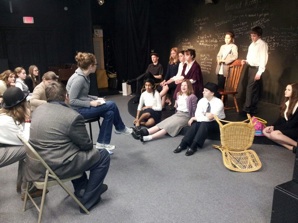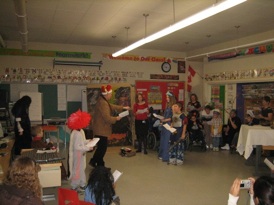ERIN NEAL
Actor, Teaching Artist
Teaching Philosophy and Artistic Statement - Erin Neal
One of the most important lessons that the arts can teach is a better understanding of the self and identity. Thus, any discussion about my work as both a teacher and an artist must include a statement about my background. I grew up in a small town in East Texas.  My father is a wildlife biologist and environmentalist and my mother is a high school math teacher. Although my parents had no specific association to the arts or theatre, they have a deep passion for literature and storytelling was always an encouraged activity in our household. Through modeled behavior, they also instilled in me a passion and commitment to social justice. Growing up I witnessed my parents assist poor immigrant families who moved into our community, visit the elderly, fight to protect threatened natural lands, and write letters to congressmen and other government leaders when they wanted to effect change in a particular issue. Because of their example, I grew to understand that serving my community was not only a duty but also a true joy. Whether working with marginalized students in the Chicago Public Schools discussing the immigrant experience or directing privileged students in the suburbs in a production of The Diary of Anne Frank, connection to a world greater than the specific artistic classroom is always part of my teaching. I am constantly striving to learn more about myself, my community, other cultures and view the world in new ways.
My father is a wildlife biologist and environmentalist and my mother is a high school math teacher. Although my parents had no specific association to the arts or theatre, they have a deep passion for literature and storytelling was always an encouraged activity in our household. Through modeled behavior, they also instilled in me a passion and commitment to social justice. Growing up I witnessed my parents assist poor immigrant families who moved into our community, visit the elderly, fight to protect threatened natural lands, and write letters to congressmen and other government leaders when they wanted to effect change in a particular issue. Because of their example, I grew to understand that serving my community was not only a duty but also a true joy. Whether working with marginalized students in the Chicago Public Schools discussing the immigrant experience or directing privileged students in the suburbs in a production of The Diary of Anne Frank, connection to a world greater than the specific artistic classroom is always part of my teaching. I am constantly striving to learn more about myself, my community, other cultures and view the world in new ways.

My first objective as a teaching artist is to incorporate social skills like working with a group, articulate communication, understanding one another’s similarities and differences, building confidence and  fostering imagination. Once these skills are introduced into the curriculum, then I work to teach specific techniques depending upon what is developmentally appropriate such as vocal aptitude, movement skills, character development and textual analysis. Finding one’s artistic voice is a beautifully complex journey that is different for each artist. My approach is to begin this process by fostering a love for the art. I work to create an environment where students feel challenged to grow both individually and as an ensemble, and I take time after every class to make notes for myself about each student so that I can better achieve this goal. Communication and collaboration with other artists, teachers, staff and parents is also an important part of my teaching style. I create curriculum that is relevant and in conjunction with the other subjects that students are taking, and I am effective at communicating with families about the sometimes difficult to articulate aspects of the theatre.
fostering imagination. Once these skills are introduced into the curriculum, then I work to teach specific techniques depending upon what is developmentally appropriate such as vocal aptitude, movement skills, character development and textual analysis. Finding one’s artistic voice is a beautifully complex journey that is different for each artist. My approach is to begin this process by fostering a love for the art. I work to create an environment where students feel challenged to grow both individually and as an ensemble, and I take time after every class to make notes for myself about each student so that I can better achieve this goal. Communication and collaboration with other artists, teachers, staff and parents is also an important part of my teaching style. I create curriculum that is relevant and in conjunction with the other subjects that students are taking, and I am effective at communicating with families about the sometimes difficult to articulate aspects of the theatre.

In regards to structure of a classroom, I believe that it is important to establish strong management systems so that students can have the freedom to explore, take risks, play, question, fail and succeed. However, it is important that this is executed in a safe environment in which students are not hurt physically or emotionally. I often begin a  session having the students help me establish class guidelines. These guidelines must include establishing signals for quiet or stillness when necessary, discussions that respect the ideas and opinions of all and the purpose and structure of the session. I like to treat my students, even very young ones, as collaborators. However, they must also respect my authority as the leader of the group. It is also important to me to create a very positive, kind classroom environment. When creating and exploring art, there is often a bit of chaos which is productive and necessary, but it is also important to control this chaos with minimum frustration or elevated volume. I design detailed lesson plans with flexibility for activities that either need to be extended or eliminated depending upon the needs of the class. I am comfortable developing my own curriculum as well as following or adapting to that of another teacher, artist or organization. Depending on whether it is developmentally appropriate or applicable to the curriculum, I often incorporate self-generated work into my classes because I believe that this is a tangible way to develop artistic voice.
session having the students help me establish class guidelines. These guidelines must include establishing signals for quiet or stillness when necessary, discussions that respect the ideas and opinions of all and the purpose and structure of the session. I like to treat my students, even very young ones, as collaborators. However, they must also respect my authority as the leader of the group. It is also important to me to create a very positive, kind classroom environment. When creating and exploring art, there is often a bit of chaos which is productive and necessary, but it is also important to control this chaos with minimum frustration or elevated volume. I design detailed lesson plans with flexibility for activities that either need to be extended or eliminated depending upon the needs of the class. I am comfortable developing my own curriculum as well as following or adapting to that of another teacher, artist or organization. Depending on whether it is developmentally appropriate or applicable to the curriculum, I often incorporate self-generated work into my classes because I believe that this is a tangible way to develop artistic voice.

I believe that helping students develop a greater sense of self leads to a better understanding of the world at large. Arts education has the power to do this in both small and large capacities. One reason that I love teaching is that I grow so much as an artist and person through observation of my students. Teaching is a way for me to continue to foster an artistic community. I consider it both an honor and a responsibility to be able to give back to a community that has blessed me with much.

